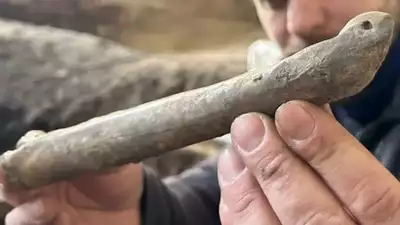De Proefkeuken is a Dutch children's show about science. In one episode, the two protagonists, Willem and Pieter, make their own skates. One of their homemade bone skates. They go to the Schaatsmuseum Hindelopen and see bone skates at about 6:20. Then they go back to their lab and create their own bone skates. They… Continue reading Bone skates in De Proefkeuken
Author: Bev
The new bone skate from Přerov
In the second half of March, Google sent me a bunch of news articles about a bone skate found in Přerov, a city in the Czech Republic. This post is a summary meant to track the evolution of the story. There are of course many more articles and blog posts about this skate. I doubt… Continue reading The new bone skate from Přerov
Skating in Comenius’s Orbis sensualium pictis
Comparing what a few editions of Comenius have to say about skating is interesting. Each edition includes Latin and one or more other languages. Let's start with a later Swedish one. Woodcut from Johannes Amos Comenius's Orbis sensualium pictus (1775 reprint) Pueri exercent se cursu, sive super glaciem 1 diabāthris 2, ubi etiam vehuntur trabis… Continue reading Skating in Comenius’s Orbis sensualium pictis
Meister Eckhart’s magic shoes
In sermon #15 of the Paradisus anime intelligentis, Meister Eckhart mentions two magic shoes: Nû schrît, edeliu sêle, ziuch ane dîne schrittschuohe, daz ist verstantnisse und minne.(Now go, noble soul, put on your walking boots, i.e., understanding and love.)Sturlese & Vinzent, 250–251 This edition calls the shoes "walking boots", but Meister Eckhart called them "schrittschuohe"… Continue reading Meister Eckhart’s magic shoes
How to stop in 1772
"How do I stop?" is usually among the first questions asked by beginning skaters. Robert Jones notes that being able to stop is important because skaters often collide and recommends three ways to stop in his book (pp. 56–57): Jump and make a quarter turn in the air [Stopping] may be easily done, by leaping… Continue reading How to stop in 1772
Skating in Thomson’s Winter
James Thomson's The Seasons was a collection of four poems, one for each season, published in the eighteenth century. Since this blog is about skating, we're interested in Winter. Winter was the first season to be published, in 1726. At that point it didn't have any skating in it. That version is available from ECCO… Continue reading Skating in Thomson’s Winter
Sonja Henie in My Lucky Star
My former colleague Ann and I wrote a paper about a Sonja Henie movie. It's pretty clear what parts each of us contributed: The skating geekery is mine, and the serious philosophy is hers. Sonja Henie on the cover of Time's July 17, 1939 issue. Courtesy of Wikimedia Commons.
Cross-grinding example
I previously wrote about what cross-grinding is and why it's not always bad. Here is a photo of one of my skates showing the distinctive marks left by cross-grinding. Cross-grinding leaves many small lines perpendicular to the length of the blade. If the cross-grinding wheel is too coarse (like the one I used with my… Continue reading Cross-grinding example
Editions of Robert Jones’s Treatise on Skating
I've sorted out the various editions of Robert Jones's Treatise on Skating in a new article. As I was doing this, I discovered several new things that aren't mentioned in my edition of his book. It seemed like lots of new stuff has come online in the last few years! And now it's time to… Continue reading Editions of Robert Jones’s Treatise on Skating
Internet articles about the Xinjiang skates
This is just a list of links with some comments. It's an interesting example of how a story spreads and grows despite a lack of reliable new information. Here's the press release from the Chinese Academy of Social Sciences by Zhou Ye (2/27/2023, in Chinese). It focuses on the non-skate finds and has roughly the… Continue reading Internet articles about the Xinjiang skates



